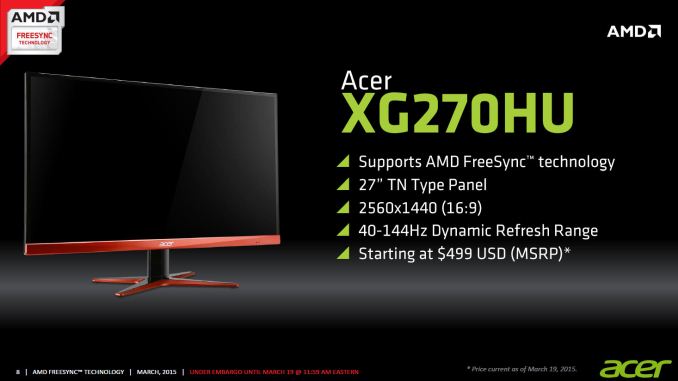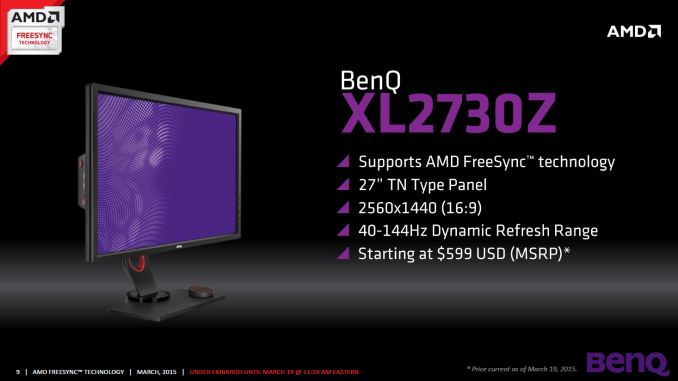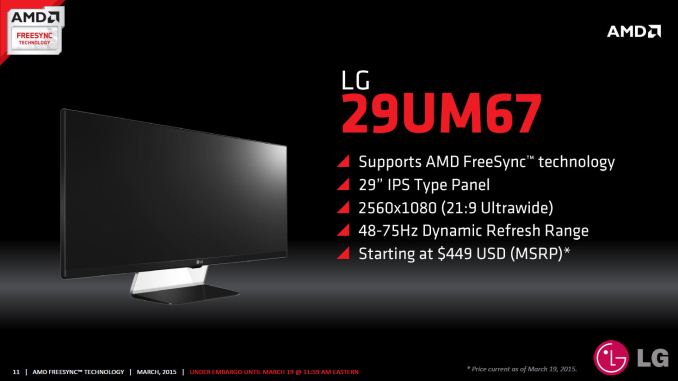The AMD FreeSync Review
by Jarred Walton on March 19, 2015 12:00 PM ESTFreeSync Displays
There are four FreeSync displays launching today, one each from Acer and BenQ, and two from LG. Besides the displays launching today, seven additional displays should show up in the coming weeks (months?). Here’s the current list of FreeSync compatible displays, with pricing where it has been disclosed.
| FreeSync Compatible Displays | ||||||
| Manufacturer | Model | Diagonal | Resolution | Refresh | Panel | Price |
| Acer | XG270HU | 27" | 2560x1440 | 40-144Hz | TN | $499 |
| BenQ | XL2730Z | 27" | 2560x1440 | 40-144Hz | TN | $599 |
| LG Electronics | 34UM67 | 34" | 2560x1080 | 48-75Hz | IPS | $649 |
| LG Electronics | 29UM67 | 29" | 2560x1080 | 48-75Hz | IPS | $449 |
| Nixeus | NX-VUE24 | 24" | 1920x1080 | 144Hz | TN | ? |
| Samsung | UE590 | 28" | 3840x2160 | 60Hz | TN | ? |
| Samsung | UE590 | 23.6" | 3840x2160 | 60Hz | TN | ? |
| Samsung | UE850 | 31.5" | 3840x2160 | 60Hz | TN? | ? |
| Samsung | UE850 | 28" | 3840x2160 | 60Hz | TN? | ? |
| Samsung | UE850 | 23.6" | 3840x2160 | 60Hz | TN? | ? |
| Viewsonic | VX2701mh | 27" | 1920x1080 | 144Hz | TN | ? |
The four displays launching today cover two primary options. For those that want higher refresh rates, Acer and BenQ have TN-based 40-144Hz displays. Both are 27” WQHD displays, so it’s quite probable that they’re using the same panel, perhaps even the same panel that we’ve seen in the ASUS ROG Swift. The two LG displays meanwhile venture out into new territory as far as adaptive refresh rates are concerned. LG has both a smaller 29” and a larger 34” 2560x1080 (UW-UXGA) display, and both sport IPS panels (technically AU Optronics' AHVA, but it's basically the same as IPS).
The other upcoming displays all appear to be using TN panels, though it's possible Samsung might offer PLS. The UE590 appears to be TN for certain, with 170/160 degree viewing angles according to DigitalTrends. The UE850 on the other hand is targeted more at imaging professionals, so PLS might be present; we'll update if we can get any confirmation of panel type.
One of the big benefits with FreeSync is going to be support for multiple video inputs – the G-SYNC displays so far are all limited to a single DisplayPort connection. The LG displays come with DisplayPort, HDMI, and DVI-D inputs (along with audio in/out), and the Acer is similarly equipped. Neither one has any USB ports, though the BenQ does have a built-in USB hub with ports on the side.
Our testing was conducted on the 34UM67, and let me just say that it’s quite the sight sitting on my desk. I’ve been bouncing between the ASUS ROG Swift and Acer XB280HK for the past several months, and both displays have their pros and cons. I like the high resolution of the Acer at times, but I have to admit that my aging eyes often struggle when running it at 4K and I have to resort to DPI scaling (which introduces other problems). The ASUS on the other hand is great with its high refresh rates, and the resolution is more readable without scaling. The big problem with both displays is that they’re TN panels, and having come from using a 30” IPS display for the past eight years that’s a pretty painful compromise.
Plopping the relatively gigantic 34UM67 on my desk is in many ways like seeing a good friend again after a long hiatus. “Dear IPS (AHVA), I’ve missed having you on my desktop. Please don’t leave me again!” For the old and decrepit folks like me, dropping to 2560x1080 on a 34” display also means reading text at 100% zoom is not a problem. But when you’re only a couple feet away, the relatively low DPI does make the pixels much more visible to the naked eye. It even has built-in speakers (though they’re not going to compete with any standalone speakers in terms of audio quality).
The launch price of $649 is pretty impressive; we’ve looked at a few other 21:9 displays in the past, and while the resolution doesn’t match LG’s 34UM95, the price is actually $50 less than the LG 34UM65’s original $699 MSRP (though it’s now being sold at $599). So at most, it looks like putting in the new technology to make a FreeSync display costs $50, and probably less than that. Anyway, we’ll have a full review of the LG 34UM67 in the coming weeks, but for now let’s return to the FreeSync discussion.
Pricing vs. G-SYNC
It certainly appears that AMD and their partners are serious about pricing FreeSync aggressively, though there aren’t direct comparisons available for some of the models. The least expensive FreeSync displays start at just $449, which matches the least expensive G-SYNC display (AOC G2460PG) on price but with generally better specs (29” 2560x1080 and IPS at 75Hz vs. 24” 1920x1080 TN at 144Hz). Looking at direct comparisons, the Acer XG270HU and BenQ XL2730Z are WQHD 144Hz panels, which pits them against the $759 ASUS ROG Swift that we recently reviewed, giving FreeSync a $160 to $260 advantage. As AMD puts it, that’s almost enough for another GPU (depending on which Radeon you’re using, of course).
Based on pricing alone, FreeSync looks poised to give G-SYNC some much needed competition. And it’s not just about the price, as there are other advantages to FreeSync that we’ll cover more on the next page. But for a moment let’s focus just on the AMD FreeSync vs. NVIDIA G-SYNC ecosystems.
Right now NVIDIA enjoys a performance advantage over AMD in terms of GPUs, and along with that they currently carry a price premium, particularly at the high end. While the R9 290X and GTX 970 are pretty evenly matched, the GTX 980 tends to lead by a decent amount in most games. Any users willing to spend $200 extra per GPU to buy a GTX 980 instead of an R9 290X might also be willing to pay $200 more for a G-SYNC compatible display. After all, it’s the only game in town for NVIDIA users right now.
AMD and other companies can support FreeSync, but until – unless! – NVIDIA supports the standard, users will be forced to choose between AMD + FreeSync or NVIDIA + G-SYNC. That’s unfortunate for any users that routinely switch between AMD and NVIDIA GPUs, though the number of people outside of hardware reviewers that regularly go back and forth is miniscule. Ideally we’d see one standard win out and the other fade away (i.e. Betamax, HD-DVD, etc.), but with a one year lead and plenty of money invested it’s unlikely NVIDIA will abandon G-SYNC any time soon.
Prices meanwhile are bound to change, as up to now there has been no competition for NVIDIA’s G-SYNC monitors. With FreeSync finally available, we expect prices for G-SYNC displays will start to come down, and in fact we’re already seeing $40-$125 off the original MSRP for most of the G-SYNC displays. Will that be enough to keep NVIDIA’s proprietary G-SYNC technology viable? Most likely, as both FreeSync and G-SYNC are gamer focused more than anything; if a gamer prefers NVIDIA, FreeSync isn’t likely to get them to switch sides. But if you don’t have any GPU preference, you’re in the market for a new gaming PC, and you’re planning on buying a new monitor to go with it, R9 290X + FreeSync could save a couple hundred dollars compared to GTX 970 + G-SYNC.
There's something else to consider with the above list of monitors as well: four currently shipping FreeSync displays exist on the official day of launch, and Samsung alone has five more FreeSync displays scheduled for release in the near future. Eleven FreeSync displays in the near term might not seem like a huge deal, but compare that with G-SYNC: even with a one year lead (more or less), NVIDIA currently only lists six displays with G-SYNC support, and the upcoming Acer XB270HU makes for seven. AMD also claims there will be 20 FreeSync compatible displays shipping by the end of the year. In terms of numbers, then, DP Adaptive Sync (and by extension FreeSync) look to be winning this war.


























350 Comments
View All Comments
JarredWalton - Thursday, March 19, 2015 - link
Try counting again: LG 29", LG 34", BenQ 27", Acer 27" -- that's four. Thanks for playing. And the Samsung displays are announced and coming out later this month or early next. For NVIDIA, there are six displays available, and one coming next month (though I guess it's available overseas). I'm not aware of additional G-SYNC displays that have been announced, so there's our six/seven. I guess maybe we can count the early moddable LCDs from ASUS (and BenQ?) and call it 8/9 if you really want to stretch things.I'm not saying G-SYNC is bad, but the proprietary nature and price are definitely not benefits for the consumer. FreeSync may not be technically superior in every way (or at least, the individual implementations in each LCD may not be as good), but open and less expensive frequently wins out over closed and more expensive.
chizow - Friday, March 20, 2015 - link
@Jarred, thanks for playing, but you're still wrong. There's 8 G-Sync panels on the market, and even adding the 1 for AMD that's still double, so how that is "nearly caught up" is certainly an interesting lens.Nvidia also has panels in the works, including 2 new, major breakthroughs like the Acer 1440p IPS, 1st 144Hz, 1440p, IPS VRR panel and the Asus ROG Swift 4K IPS, 1st 4K IPS VRR monitor. So yes, while AMD is busy "almost catching up" with low end panels, Nvidia and their partners are continuing to pioneer the tech.
As for FreeSync bringing up the low end, I personally think it would be great if Nvidia adopted AdaptiveSync for their low end solutions and continued to support G-Sync as their premium solution. It would be great for the overwhelming majority of the market that owns Nvidia already, and would be one less reason for anyone to buy a Radeon card.
TheJian - Sunday, March 22, 2015 - link
You sure have a lot of excuses. This is beta 1.0, it's the lcd's fault (pcper didn't think so), assumption that open/free (this isn't free, $50 by your own account for freesync, which is the same as $40-60 for the gsync module right?, you even admit they're hiking prices at the vendor side for $100+) is frequently the winner. Ummm, tell that to CUDA and NV's generally more expensive cards. There is a reason they have pricing power (the are better), and own 70% discrete and ~75% workstation market. I digress...anubis44 - Tuesday, March 24, 2015 - link
@chizow:"I'll bet on the market leader that holds a commanding share of the dGPU market, consistently provides the best graphics cards, great support and features, and isn't riddled with billions in debt with a gloomy financial outlook."
You mean you'll bet on the crooked, corrupt, anti-competitive, money-grubbing company that doesn't compensate their customers when they rip them off (bumpgate), and has no qualms about selling them a bill of goods (GTX970 has 4GB ram! Well, 3.5GB of 'normal' speed ram, and .5GB of much slower, shitty ram.), likes to pay off game-makers to throw in trivial nVidia proprietary special effects (Batman franchise and PhysX, I'm looking right at you)? That company? Ok, you keep supporting the rip-off GPU maker, and see how this all ends for you.
chizow - Tuesday, March 24, 2015 - link
@Anubis44: Yeah again, I don't bother with any of that noise. The GTX 970 I bought for my wife in Dec had no adverse impact from the paper spec change made a few months ago, it is still the same fantastic value and perf it was the day it launched.But yes I am sure ignoramuses like yourself are quick to dismiss all the deceptive and downright deceitful things AMD has said in the past about FreeSync, now that we know its not really Free, can't be implemented with a firmware flash, does in fact require additional hardware, and doesn't even work with many of AMD's own GPUs. And how about CrossFireX? How long did AMD steal money from end-users like yourself on a solution that was flawed and broken for years on end, even denying there was a problem until Nvidia and the press exposed it with that entire runtframe FCAT fiasco?
And bumpgate? LMAO. AMD fanboys need to be careful who they point the finger at, especially in the case of AMD there's usually 4 more fingers pointed back at them. How about that Llano demand overstatement lawsuit still ongoing that specifically names most of AMD's exec board, including Read? How about that Apple extended warranty and class action lawsuit regarding the same package/bump issues on AMD's MacBook GPUs?
LOL its funny because idiots like you think "money-grubbing" is some pejorative and greedy companies are inherently evil, but then you look at AMD's financial woes and you understand they can only attract the kind of cheap, ignorant and obtusely stubborn customers LIKE YOU who won't even spend top dollar on their comparably low-end offerings. Then you wonder why AMD is always in a loss position, bleeding money from every orifice, saddled in debt. Because you're waiting for that R9 290 to have a MIR and drop from $208.42 to $199.97 before you crack that dusty wallet open and fork out your hard-earned money.
And when there is actually a problem with AMD product, you would rather make excuses for them and sweep those problems under the rug, rather than demand better product!
So yes, in the end, you and AMD deserve one another, for as long as it lasts anyways.
Yojimbo - Thursday, March 19, 2015 - link
HD-DVD was technically superior and higher cost? It seems BlueRay/HD-DVD is a counterexample to what you are saying, but you include it in the list to your favor. Laserdisc couldn't record whereas VCRs could. Minidisc was smaller and offered recording, but CD-R came soon after and then all it had was the smaller size. Finally MP3 players came along and did away with it.There's another difference in this instance, though, which doesn't apply to any of those situations that I am aware of, other than minidisc ): G-Sync/FreeSync are linked to an already installed user base of requisite products. (Minidisc was going up against CD libraries, although people could copy those. In any case, minidisc wasn't successful and was going AGAINST an installed user base.) NVIDIA has a dominant position in the installed GPU base, which is probably exactly the reason that NVIDIA chose to close off G-Sync and the "free" ended up being in FreeSync.
Assuming variable refresh catches on, if after some time G-Sync monitors are still significantly more expensive than FreeSync ones, it could become a problem for NVIDIA and they may have to either work to reduce the price or support FreeSync.
chizow - Thursday, March 19, 2015 - link
Uh, HD-DVD was the open standard there guy, and it lost to the proprietary one: Blu-Ray. But there's plenty of other instances of proprietary winning out and dominating, let's not forget Windows vs. Linux, DX vs. OpenGL, CUDA vs. OpenCL, list goes on and on.Fact remains, people will pay more for the better product, and better means better results, better support. I think Nvidia has shown time and again, that's where it beats AMD, and their customers are willing to pay more for it.
See: Broken Day 15 CF FreeSync drivers as exhibit A.
at80eighty - Thursday, March 19, 2015 - link
Keep paddling away, son. The ship isn't sinking at allchizow - Thursday, March 19, 2015 - link
If you buy a FreeSync monitor you will get 2-3 paddles for every 1 on a G-Sync panel. That will certainly help you pedal faster.http://www.pcper.com/image/view/54234?return=node%...
at80eighty - Friday, March 20, 2015 - link
oh hey great example - no ghosting there at all. brilliant!